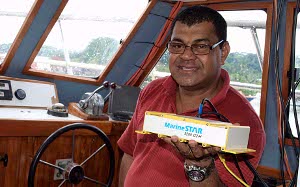Thursday 19 September 2013, Secretariat of the Pacific Community (SPC), Suva, Fiji – On Friday, 1 November 2013, the Secretariat of the Pacific Community’s Applied Geoscience and Technology Division (SOPAC) will recognize the outstanding service of eleven employees, all of whom have given more than twenty years to the organization. The contributions of such dedicated employees have made it possible for the SOPAC Division to meet its goal of supporting the sustainable development of Pacific communities, whilst building the reputation of a reliable and effective geoscience services provider.
SOPAC has a long history in the Pacific. First established in 1972 as a United Nations Development Programme Regional Project, the South Pacific Applied Geoscience Commission, or SOPAC, initially focused on exploring Pacific mineral and hydro-carbon potential. Over the years, SOPAC’s programme of work has shifted to include coastal protection and management, geohazard assessment, water resource management, and disaster risk management. In 1990, SOPAC became an independent regional organization. In 2011, the organization integrated with the Secretariat of the Pacific Community (SPC), becoming the newest division of SPC.
The eleven employees to be recognized on 1 November 2013 have witnessed firsthand many changes within the organisation, the region and, of course, technology over the years.
One of the award recipients, Mr Peni Musunamasi, started with SOPAC in 1989. ‘I travelled up the ranks at SOPAC. I started as an assistant electronic technician, all the way up to senior electronic technician. I then became acting electronic engineer, electronic engineer, and now I’m Team leader for the Technical Workshop,’ recalls Musunamasi. ‘We used to be two officers, but I now have five staff under me.’
Musunamasi marvels at the differences between early technology and what is used today. ‘We used to use a trisponder system to pinpoint our position out at sea. There was no GPS back then.
You’d have to go up to the mountains, carrying heavy batteries and solar panels. Then when you were at sea, all of a sudden, your station might cut off. You would have to stop the survey, get off the boat and climb the mountain to see what had gone wrong. Now, we have a Marinestar navigation system we can take with us on the boat that corrects itself.’
Shipping equipment was another challenge for Peni that has changed over the years. ‘I went to PNG on a survey in 1990 with the trisponder system in nine big boxes. Now I can take a whole GPS system with me in my carry-on,’ he explains.
‘It was quite a struggle. I’ve worked under many different directors and different environments, but I am happy where I am today,’ says Musunimasi. ‘It’s been good because only through experience can we continue to upgrade our expertise and the services we provide to member countries.’
With operations based out of the Nabua Road campus in Suva, Fiji, the SOPAC Division employs 85 staff who work throughout the Pacific on programmes aimed at improving livelihoods and reducing vulnerability to disasters, hazards and climate change. In the last year alone, some of the projects undertaken by SOPAC include: tsunami modelling and disaster planning for the island of Tongatapu in Tonga; technical support for the successful delineation of maritime boundaries between the USA and Kiribati; providing legal counsel for Pacific countries exploring deep-sea mining potential; digital mapping of Nadi River Basin to develop a flood inundation model; exploring sustainable wave-driven energy options in Samoa; and sustainable sanitation awareness programmes and installation of more than 40 compost toilets in Tuvalu, to name a few.
The SOPAC Division is grateful to these long-term staff members and joins together with the rest of SPC to thank them for their service to Pacific member countries and toward the advancement of applied geoscience in the Pacific.
For more information, contact Molly Powers (tel: +679 338 1377; email: This e-mail address is being protected from spambots. You need JavaScript enabled to view it ) or visit the SPC website: www.spc.int.






